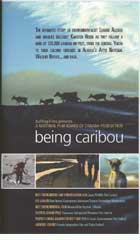
Being Caribou 2004
Distributed by Bullfrog Films, PO Box 149, Oley, PA 19547; 800-543-FROG (3764)
Produced by Tracey Friesen
Directed by Leanne Allison and Diana Wilson
VHS, color, 54 min.
Sr. High - Adult
Environmental Studies, Science, Biology, Arctic Studies, Energy, Ecology, Animal Behavior, Animal Conservation
Date Entered: 11/17/2006
Reviewed by Geetha Yapa, Science Library, University of California, RiversideIn this award-winning documentary the husband and wife team of environmentalist and filmmaker Leanne Allisson, and wildlife biologist Karsten Heuer, takes the viewer on a journey from Yukon, Canada to the caribou calving grounds in Alaska and back. They follow the caribou on foot for five months through beautiful but rugged terrain and harsh climatic conditions. Leanne and Karsten experience what it means to be “caribou” as they face the same hardships and dangers as the animals, having close encounters with hungry grizzly bears and wolves, and enduring hunger, fatigue and biting insects. The couple undertakes this long and arduous journey in order to get to know the caribou, to observe the hardships the caribou have to undergo during their annual migration and to find out how the herd will be affected by possible development of gas and oil reserves on the caribou calving grounds in Alaska.
The Arctic National Wildlife Refuge’s coastal tundra area has been the preferred birthing ground for the Porcupine Caribou Herd because it provides a relatively safe place to stop, feed and rest during the calving period and also because it provides the particular type of grass needed to produce high quality milk. The herds have been following their natural instincts and migrating to these grounds for thousands of years, but it is uncertain how long they will be able to follow this tradition because politicians and oil executives in the US are looking for ways to open the area for oil and gas developments.
Being Caribou is about birth, death and survival. By following the caribou, Leanne and Karsten discover how fragile and vulnerable these animals are, especially during the calving season. The film stresses the critical importance of protecting the calving areas where caribou feel secure to ensure future survival of the species. Observing the animals on such an intimate level makes one realize how impossible it is for the caribou to co-exist with any kind of developments or changes to their natural environment.
Armed with their firsthand knowledge and evidence, Leanne and Karsten go to Washington, DC in an effort to make their story heard. Failing to influence the lawmakers, they change their strategy and decide to work from the bottom up. This film goes a long way in supporting their noble cause. It is a “must see” for all those who are in favor of destroying a pristine natural environment along with all life forms in it, to gain a few barrels of oil.
Highly recommended for high school, college and public library collections
Awards:
- Best Environment and Conservation Film, Japan Wildlife Film Festival
- Best Documentary Program or Series & Best Overall Sound, Leo Awards
- Best Environmental Film, MountainFilm, Telluride
- Grand Prize, Vancouver International Mountain Film Festival
- Jury Award, Flagstaff Mountain Film Festival
- Audience Award, Victoria Independent Film and Video Festival
- People's Choice Award, Calgary International Film Festival
- Federal Express Award for Most Popular Canadian Film, Vancouver International Film Festival
- People's Choice Award, Wild & Scenic Environmental Film Festival
- Best Nature Film, International Nature and Environmental (PINE) Film Festival
- Best Environmental Film, Kendal Mountain Film Festival, Germany
- Best 'Earth' Film, International Festival of Mountain Film and Adventure, Bratislava, Slovakia
- Merit Award, International Wildlife Film Festival, Missoula
- Honorable Mention, EarthVision Film & Video Festival